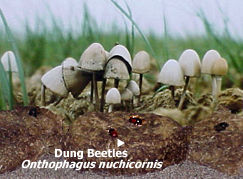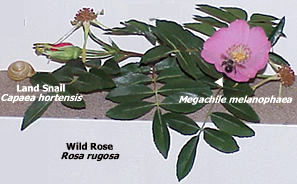|
 The Island's narrow interior lies between
two long ridges of stabilized sand dunes. The dunes give enough shelter
for a thick green carpet of plants, mostly grasses with scattered areas
of heath. Even here, trees cannot survive. The heath plants and their
community are the last stage of natural ecological change on Sable
Island.
The Island's narrow interior lies between
two long ridges of stabilized sand dunes. The dunes give enough shelter
for a thick green carpet of plants, mostly grasses with scattered areas
of heath. Even here, trees cannot survive. The heath plants and their
community are the last stage of natural ecological change on Sable
Island.
|
|

The grassland plants are mostly Marram, with some Beach
Pea plus a variety of other grasses, low plants and shrubs.
|
Horses graze on the plants and horse
dung returns nutrients to the soil. Even the dung becomes a habitat
and a food source for Dung Beetles.
Even in the sheltered grasslands,
Sable's strong winds are a powerful force preventing plants from
growing tall. Some common bushy plants such as Wild Rose grow here
in dwarfed forms.
|
 |

Leaf-cutting Bees eat the rose pollen and line their sand
burrows with oval plates cut from rose leaves.
Land Snail shells are thin
on Sable, due to lack of calcium in the soil.
|
|
Sphinx
Moth
Sphinx gordius
|
| Despite the
salt spray, Sable Island's soils are not salty. Rain
washes the salt away, leaving the soil slightly acidic.
Heath plants such as Juniper,
Bayberry, Crowberry, Blueberry and Cranberry thrive.
The caterpillars of Sphinx Moths feed on Bayberry
leaves. |
|
|
|
Cranberry
Vaccinium macrocarpon |
|
There
are no native trees on Sable Island. This tiny pine
was planted more than 30 years ago.
Pinus
sylvestris
|
|
|









